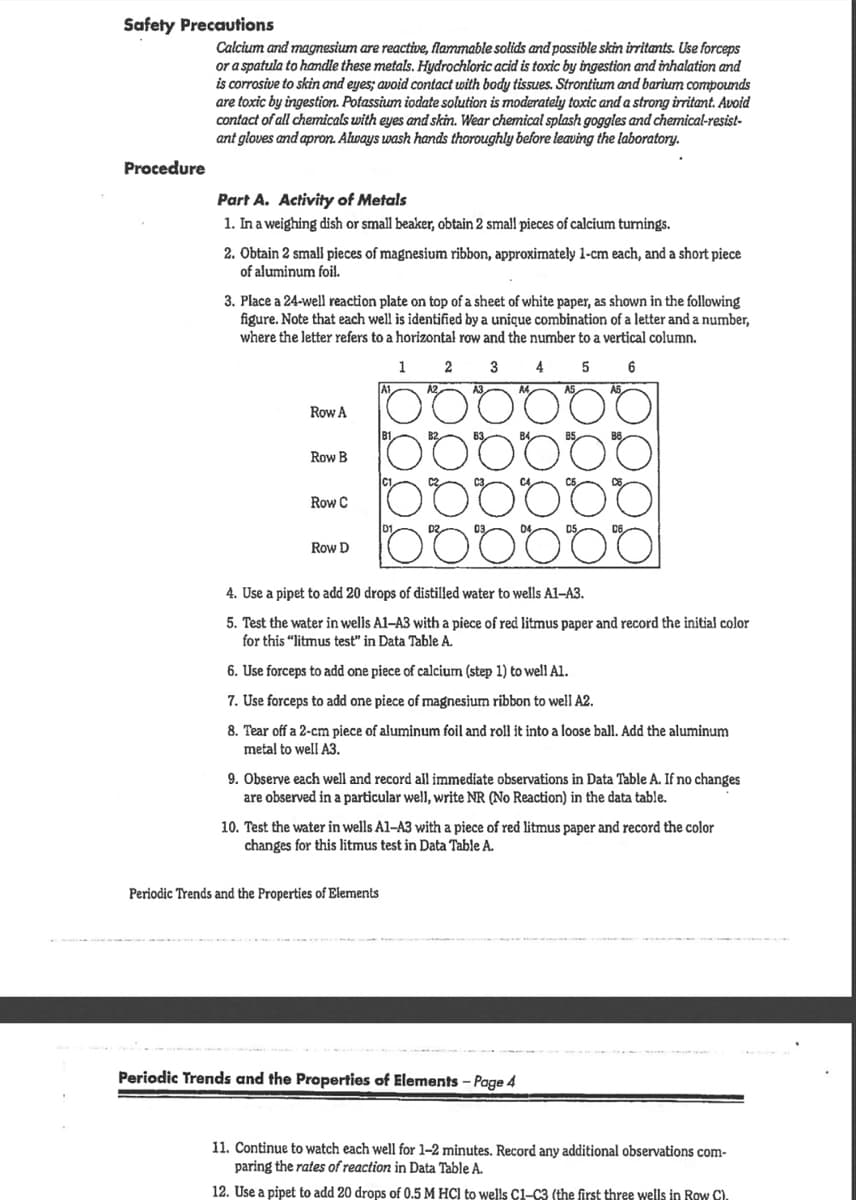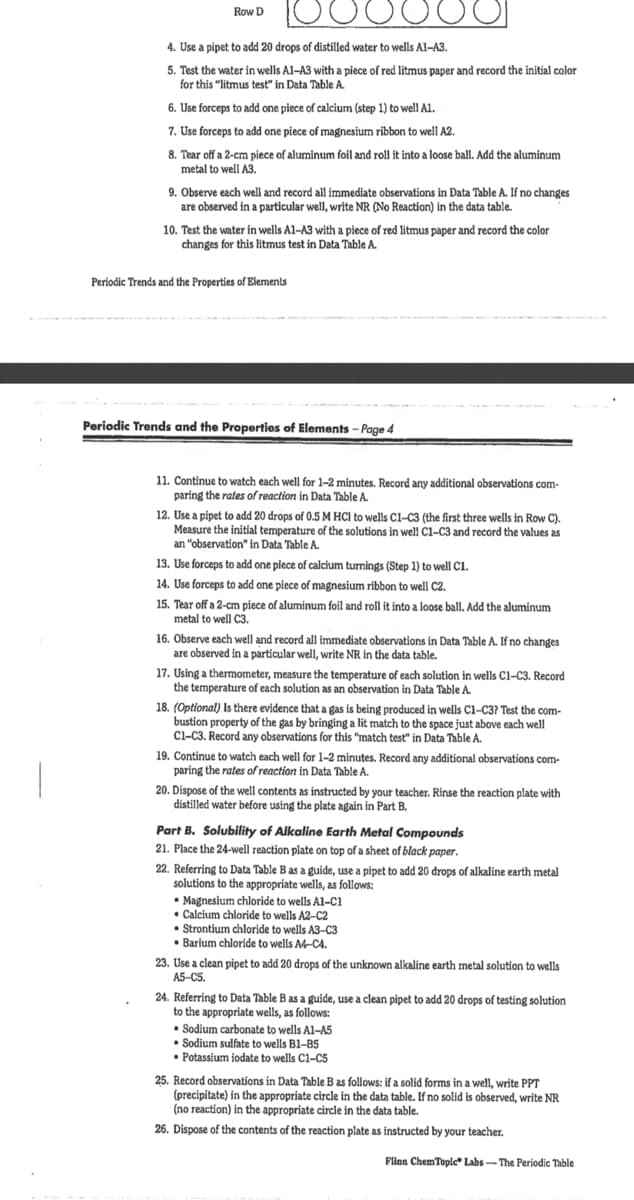Read the entire procedure and the recommended safety precautions. you think extra pieces of calcium or magnesium metal should be disposed of down the drain? or why not?
Read the entire procedure and the recommended safety precautions. you think extra pieces of calcium or magnesium metal should be disposed of down the drain? or why not?
Chemistry: Matter and Change
1st Edition
ISBN:9780078746376
Author:Dinah Zike, Laurel Dingrando, Nicholas Hainen, Cheryl Wistrom
Publisher:Dinah Zike, Laurel Dingrando, Nicholas Hainen, Cheryl Wistrom
Chapter6: The Periodic Table And Periodic Law
Section6.2: Classification Of The Elements
Problem 13SSC
Related questions
Question
Read the entire procedure and the recommended safety precautions. you think extra pieces of calcium or magnesium metal should be disposed of down the drain? or why not?

Transcribed Image Text:Safety Precautions
Calcium and magnmesium are reactive, flammable solids and possible skin irritants. Use forceps
or a spatula to handle these metals. Hydrochloric acid is toxic by ingestion and inhalation and
is corrosive to skin and eyes; avoid contact with body tissues. Strontium and barium compounds
are toxic by ingestion. Potassium iodate solution is moderately toxic and a strong irritant. Avoid
contact of all chemicals with eyes and skin. Wear chemical splash goggles and chemical-resist-
ant gloves and apron. Always wash hands thoroughly before leaving the laboratory.
Procedure
Part A. Activity of Metals
1. In a weighing dish or small beaker, obtain 2 small pieces of calcium turnings.
2. Obtain 2 smal pieces of magnesium ribbon, approximately 1-cm each, and a short piece
of aluminum foil.
3. Place a 24-well reaction plate on top of a sheet of white paper, as shown in the following
figure. Note that each well is identified by a unique combination of a letter and a number,
where the letter refers to a horizontal row and the number to a vertical column.
Row A
Row B
Row C
Row D
4. Use a pipet to add 20 drops of distilled water to wells A1-A3.
5. Test the water in wells Al-A3 with a piece of red litmus paper and record the initial color
for this “litmus test" in Data Table A.
6. Use forceps to add one piece of calcium (step 1) to well Al.
7. Use forceps to add one piece of magnesium ribbon to well A2.
8. Tear off a 2-cm piece of aluminum foil and roll it into a loose ball. Add the aluminum
metal to well A3.
9. Observe each well and record all immediate observations in Data Table A. If no changes
are observed in a particular well, write NR (No Reaction) in the data table.
10. Test the water in wells Al-A3 with a piece of red litmus paper and record the color
changes for this litmus test in Data Table A.
Periodic Trends and the Properties of Elements
Periodic Trends and the Properties of Elements – Page 4
11. Continue to watch each well for 1–2 minutes. Record any additional observations com-
paring the rates of reaction in Data Table A.
12. Use a pipet to add 20 drops of 0.5 M HÇI to wells C1-C3 (the first three wells in Row C).

Transcribed Image Text:Row D
4. Use a pipet to add 20 drops of distilled water to wells Al-A3.
5. Test the water in wells Al-A3 with a piece of red litmus paper and record the initial color
for this "litmus test" in Data Table A.
6. Use forceps to add one piece of calcium (step 1) to well A1.
7. Use forceps to add one piece of magnesium ribbon to well A2.
8. Tear off a 2-cm piece of aluminum foil and roll it into a loose ball. Add the aluminum
metal to well A3.
9. Observe each well and record all immediate observations in Data Table A. If no changes
are observed in a particular well, write NR (No Reaction) in the data table.
10. Test the water in wells Al-A3 with a piece of red litmus paper and record the color
changes for this litmus test in Data Table A.
Periodic Trends and the Properties of Elements
Periodic Trends and the Properties of Elements – Page 4
11. Continue to watch each well for 1-2 minutes. Record any additional observations com-
paring the rates of reaction in Data Table A.
12. Use a pipet to add 20 drops of 0.5 M HC) to wells Cl-C3 (the first three wells in Row C).
Measure the initial temperature of the solutions in well C1-C3 and record the values as
an "observation" in Data Table A.
13. Use forceps to add one piece of calcium turnings (Step 1) to well C1.
14. Use forceps to add one piece of magnesium ribbon to well C2.
15. Tear off a 2-cm piece of aluminum foil and roll it into a loose ball. Add the aluminum
metal to well C3.
16. Observe each well and record all immediate observations in Data Table A. If no changes
are observed in a particular well, write NR in the data table.
17. Using a thermometer, measure the temperature of each solution in wells C1-C3. Record
the temperature of each solution as an observation in Data Table A.
18. (Optional) Is there evidence that a gas is being produced in wells Ci-C3? Test the com-
bustion property of the gas by bringing a lit match to the space just above each well
Cl-C3. Record any observations for this "match test" in Data Table A.
19. Continue to watch each well for 1-2 minutes. Record any additional observations com-
paring the rates of reaction in Data Table A.
20. Dispose of the well contents as instructed by your teacher. Rinse the reaction plate with
distilled water before using the plate again in Part B.
Part B. Solubility of Alkaline Earth Metal Compounds
21. Place the 24-well reaction plate on top of a sheet of black paper.
22. Referring to Data Table B as a guide, use a pipet to add 20 drops of alkaline earth metal
solutions to the appropriate wells, as follows:
• Magnesium chloride to wells Al-C1
• Calcium chloride to wells A2-C2
Strontium chloride to wells A3-C3
• Barium chloride to wells A4-CA.
23. Use a clean pipet to add 20 drops of the unknown alkaline earth metal solution to wells
A5-CS.
24. Referring to Data Table B as a guide, use a clean pipet to add 20 drops of testing solution
to the appropriate wells, as follows:
Sodium carbonate to wells Al-A5
• Sodium sulfate to wells B1-B5
Potassium iodate to wells C1-C5
5
25. Record observations in Data Table B as follows: if a solid forms in a well, write PPT
(precipitate) in the appropriate circle in the data table. If no solid is observed, write NR
(no reaction) in the appropriate circle in the data table.
26. Dispose of the contents of the reaction plate as instructed by your teacher.
Flinn ChemTople* Labs- The Periodic Table
Expert Solution
This question has been solved!
Explore an expertly crafted, step-by-step solution for a thorough understanding of key concepts.
This is a popular solution!
Trending now
This is a popular solution!
Step by step
Solved in 2 steps

Recommended textbooks for you

Chemistry: Matter and Change
Chemistry
ISBN:
9780078746376
Author:
Dinah Zike, Laurel Dingrando, Nicholas Hainen, Cheryl Wistrom
Publisher:
Glencoe/McGraw-Hill School Pub Co

Chemistry
Chemistry
ISBN:
9781305957404
Author:
Steven S. Zumdahl, Susan A. Zumdahl, Donald J. DeCoste
Publisher:
Cengage Learning

Chemistry: An Atoms First Approach
Chemistry
ISBN:
9781305079243
Author:
Steven S. Zumdahl, Susan A. Zumdahl
Publisher:
Cengage Learning

Chemistry: Matter and Change
Chemistry
ISBN:
9780078746376
Author:
Dinah Zike, Laurel Dingrando, Nicholas Hainen, Cheryl Wistrom
Publisher:
Glencoe/McGraw-Hill School Pub Co

Chemistry
Chemistry
ISBN:
9781305957404
Author:
Steven S. Zumdahl, Susan A. Zumdahl, Donald J. DeCoste
Publisher:
Cengage Learning

Chemistry: An Atoms First Approach
Chemistry
ISBN:
9781305079243
Author:
Steven S. Zumdahl, Susan A. Zumdahl
Publisher:
Cengage Learning


Chemistry by OpenStax (2015-05-04)
Chemistry
ISBN:
9781938168390
Author:
Klaus Theopold, Richard H Langley, Paul Flowers, William R. Robinson, Mark Blaser
Publisher:
OpenStax

General Chemistry - Standalone book (MindTap Cour…
Chemistry
ISBN:
9781305580343
Author:
Steven D. Gammon, Ebbing, Darrell Ebbing, Steven D., Darrell; Gammon, Darrell Ebbing; Steven D. Gammon, Darrell D.; Gammon, Ebbing; Steven D. Gammon; Darrell
Publisher:
Cengage Learning